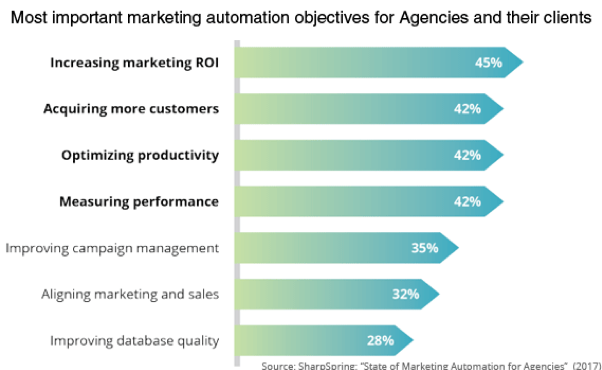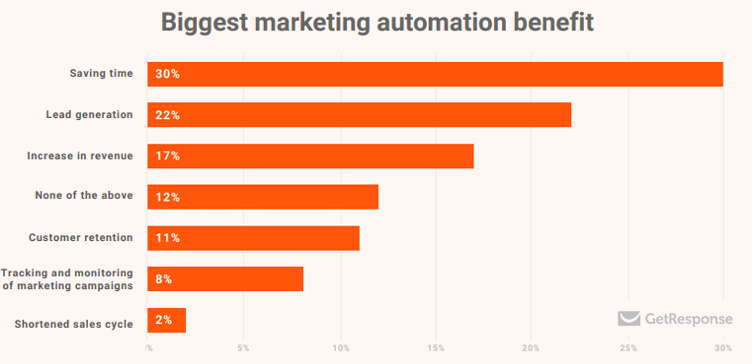Successful implementation of technology solutions for smarter, quicker, more successful marketing
Marketing technologies can often be considered a dark art. They are normally quite complex to implement correctly within any size of organisation. The aim should be to reduce marketing budgets, increase messaging intelligence, targeting smaller and more engaged individuals at the right time. Most organisations will take the approach of purchasing many ‘off-the-shelf’ software solutions, almost with the expectation that once ‘installed’, it will solve most of their problems.
Looking at the most common objectives for these technology tools;
And aligning them to the most common benefits;
When reality does not meet expectations, this can lead to high levels of frustration, especially if the investment for new software comes with a hefty price tag, and even more so if you factor in precious staff salary hours wasted in bad implementations.
There are bullet proof methods for good implementations, so it’s not all doom and gloom. The key is in fact data, not the technology. Here is my golden checklist steps for a bulletproof implementation of any new marketing or CRM solution;
- Create a project plan. Start simple but add details and keep it up to date as you work through each stage.
- Start with business goals and ensure you have an honest budget. More often than not, business goals are not clear, directly setting up for failure before getting out of the starting blocks. Having an understanding of both an implementation budget and ongoing marketing budget is paramount. Be honest, research what competitors spend and ask sector specialist agencies for advice on what you should be spending on marketing.
- Data first, platform second and analyse your customer data. Most organisations will have customer details stored in many locations, sales/invoicing/billing tools/CRM platforms/websites etc. These sources need analysis to discover the quality and consistency of potential usable fields, validity of their GDPR status and consent and to understand if they can be automatically integrated with a new platform without human intervention.
- Create a data map. In both a visual form and also with detailed notes on issues, compatibility and direction of data flows. This should align to GDPR/Data Protection Act compliance regulation.
- Create a lead handling plan. This is a very important living and breathing document detailing how your sales staff are to handle leads and change their status with your core sales tool. This is important for marketing automation, as it will detail the level of automation possible and drive your triggers for starting the automated messages.
- Create a customer journey/CRM plan. Another very important document that will detail the creative touch points and help build a picture of how many creative assets you will need.
- Create a new platform tender or an existing platform implementation plan. If you have already purchased a marketing automation tool, don’t panic. Most modern platforms can all do the same job but get a Platform Specialist to help with implementing a way to get the most out of the tool and design a process that works for your organisation. It’s important to understand that you can’t do this task successfully unless the data is in place. The data will drive the effective use of any good marketing automation tool. If you are still on the hunt for a platform, I would start with a tender document, or ask a platform agnostic specialist/agency to help create a tender document for you.
- Rollout. This will involve creating the first set of assets required for fully automated paths and ideally, very clever platform specific editable templates that can be used for ad hoc campaigns.
- Upkeep plan. Return on investment can be depreciated very quickly without an understanding that marketing automation is based on behavioural science, which means that what works once will not always work. People change, circumstances change and so should your marketing messages and strategies. A good tool will help you understand your customers and allow you to adapt and evolve your messaging to reach them more effectively. Ensure that your budget has monthly allowance for upkeep.
Understanding self-serve
Almost all organisations have two goals, to reduce budgets and get more for their money. A very cost-effective way of doing this would be to merge self-serve platforms into an upkeep plan. All marketing automation tools will have great campaign builders and template editing tools, but these need to be created correctly and what most organisations don’t realise, is they still take up precious staff hours to manipulate. At the same time, getting new platform ready assets from creative agencies can be problematic, slow and expensive. Technology can help make this less painful. Injecting self-serve platforms to allow collaboration and quality control can help speed up new asset creation or provide better brand consistency for all messaging. Self-serve platforms are heavily customised and generally proprietary within the creative agency world. Good self-serve platforms will bring agency level workflow, approvals, estimating and project management into your organisation, giving you the best of both worlds. Agency creativity but at a fraction of the cost.
Author: Mark Pearson – Technical Director at Aylesworth Fleming.
September 2019.
SOURCES:
[1] Mark Pearson, Technical Director, Aylesworth Fleming Ltd. Marketing automation & data driven marketing expert with over 20 years’ experience in the field.
[2] https://www.emailmonday.com/marketing-automation-statistics-overview/
[3] https://sharpspring.com/resources/state-marketing-automation-infographic/






